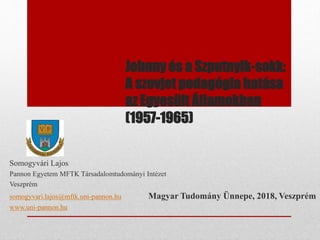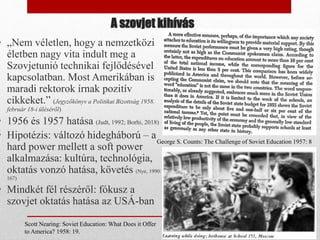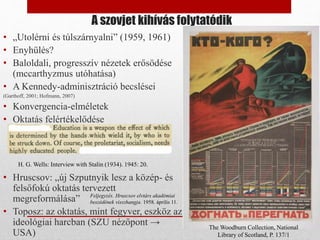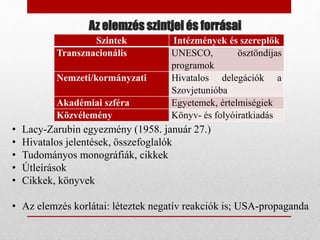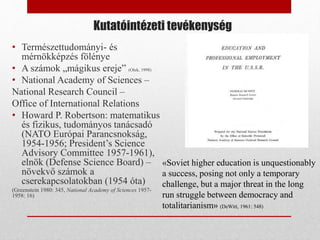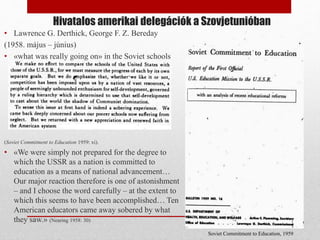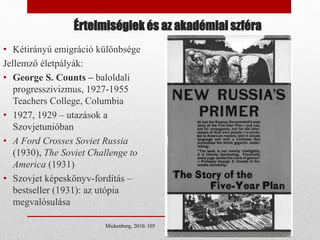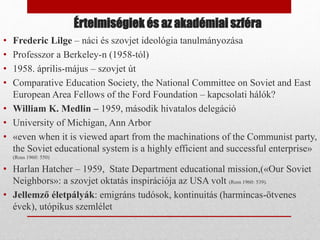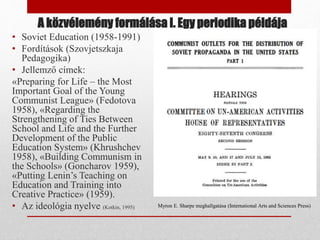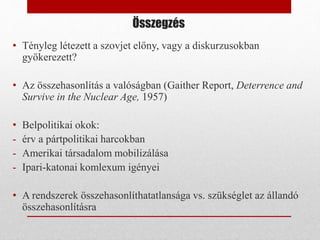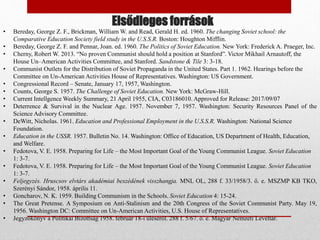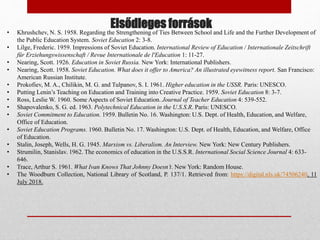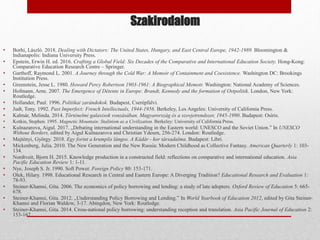Johnny ÃĐs a Szputnyik-sokk
- 1. Johnny ÃĐs a Szputnyik-sokk: A szovjet pedagÃģgia hatÃĄsa az EgyesÞlt Ãllamokban (1957-1965) SomogyvÃĄri Lajos Pannon Egyetem MFTK TÃĄrsadalomtudomÃĄnyi IntÃĐzet VeszprÃĐm somogyvari.lajos@mftk.uni-pannon.hu Magyar TudomÃĄny Ãnnepe, 2018, VeszprÃĐm www.uni-pannon.hu
- 2. Az elÅadÃĄs szerkezete âĒ ProblÃĐmafelvetÃĐs âĒ Az elemzÃĐs szintjei ÃĐs forrÃĄsai âĒ ElmÃĐleti kontextus âĒ Az UNESCO szerepe âĒ Az amerikai adminisztrÃĄciÃģ lÃĄtogatÃĄsai ÃĐs jelentÃĐsei âĒ ÃrtelmisÃĐgiek, vÃĐlemÃĐnyek âĒ A kÃķzvÃĐlemÃĐny âĒ ÃsszegzÃĐs âĒ Irodalom Current Intelligence Weekly Summary, 21 April 1955, CIA, C03186010. Approved for Release: 2017/09/07
- 3. A szovjet kihÃvÃĄs âĒ âNem vÃĐletlen, hogy a nemzetkÃķzi ÃĐletben nagy vita indult meg a SzovjetuniÃģ technikai fejlÅdÃĐsÃĐvel kapcsolatban. Most AmerikÃĄban is maradi rektorok Ãrnak pozitÃv cikkeket.â (JegyzÅkÃķnyv a Politikai BizottsÃĄg 1958. februÃĄr 18-i ÞlÃĐsÃĐrÅl) âĒ 1956 ÃĐs 1957 hatÃĄsa (Judt, 1992; Borhi, 2018) âĒ HipotÃĐzis: vÃĄltozÃģ hideghÃĄborÚ â a hard power mellett a soft power alkalmazÃĄsa: kultÚra, technolÃģgia, oktatÃĄs vonzÃģ hatÃĄsa, kÃķvetÃĐs (Nye, 1990: 167) âĒ MindkÃĐt fÃĐl rÃĐszÃĐrÅl: fÃģkusz a szovjet oktatÃĄs hatÃĄsa az USÃ-ban George S. Counts: The Challenge of Soviet Education 1957: 8 Scott Nearing: Soviet Education: What Does it Offer to America? 1958: 19.
- 4. Az amerikai reakciÃģ (1956-1958) âĒ Ãjfajta viszonyok: bÃĐkÃĐs egymÃĄs mellett ÃĐlÃĐs ÃĐs verseny (konfrontÃĄciÃģ ÃĐs kompetÃciÃģ) âĒ Å°rverseny ÃĐs oktatÃĄsi verseny âĒ 1956 â SzimpÃģzium a Kongresszusban âĒ LemaradÃĄs veszÃĐlye - mÃĄr a Szputnyik-sokk elÅtt âĒ NDEA, 1958 The Great Pretense: A Symposium on Anti-Stalinism and the 20th Congress of Soviet Communist Party. 19 May 1956: 84, 88 Congressional Record â Senate, January 17, 1957, Washington: 681.
- 5. A szovjet kihÃvÃĄs folytatÃģdik âĒ âUtolÃĐrni ÃĐs tÚlszÃĄrnyalniâ (1959, 1961) âĒ EnyhÞlÃĐs? âĒ Baloldali, progresszÃv nÃĐzetek erÅsÃķdÃĐse (mccarthyzmus utÃģhatÃĄsa) âĒ A Kennedy-adminisztrÃĄciÃģ becslÃĐsei (Garthoff, 2001; Hofmann, 2007) âĒ Konvergencia-elmÃĐletek âĒ OktatÃĄs felÃĐrtÃĐkelÅdÃĐse âĒ Hruscsov: âÚj Szputnyik lesz a kÃķzÃĐp- ÃĐs felsÅfokÚ oktatÃĄs tervezett megreformÃĄlÃĄsaâ âĒ Toposz: az oktatÃĄs, mint fegyver, eszkÃķz az ideolÃģgiai harcban (SZU nÃĐzÅpont â USA) The Woodburn Collection, National Library of Scotland, P. 137/1 H. G. Wells: Interview with Stalin (1934). 1945: 20. FeljegyzÃĐs. Hruscsov elvtÃĄrs akadÃĐmiai beszÃĐdÃĐnek visszhangja. 1958. ÃĄprilis 11.
- 6. Az elemzÃĐs szintjei ÃĐs forrÃĄsai Szintek IntÃĐzmÃĐnyek ÃĐs szereplÅk TransznacionÃĄlis UNESCO, ÃķsztÃķndÃjas programok Nemzeti/kormÃĄnyzati Hivatalos delegÃĄciÃģk a SzovjetuniÃģba AkadÃĐmiai szfÃĐra Egyetemek, ÃĐrtelmisÃĐgiek KÃķzvÃĐlemÃĐny KÃķnyv- ÃĐs folyÃģiratkiadÃĄs âĒ Lacy-Zarubin egyezmÃĐny (1958. januÃĄr 27.) âĒ Hivatalos jelentÃĐsek, ÃķsszefoglalÃģk âĒ TudomÃĄnyos monogrÃĄfiÃĄk, cikkek âĒ ÃtleÃrÃĄsok âĒ Cikkek, kÃķnyvek âĒ Az elemzÃĐs korlÃĄtai: lÃĐteztek negatÃv reakciÃģk is; USA-propaganda
- 7. ElmÃĐleti kontextus âĒ A baloldali ÃĐrtelmisÃĐgiek szerepe a Nyugati vilÃĄgban (Hollander, 1996) TÃĄrsutasok ÃĐs szimpatizÃĄnsok ÚtleÃrÃĄsai SzelektÃv nÃĐzÅpont, illÚziÃģk, a valÃģsÃĄg eltorzÃtÃĄsa âĒ Az oktatÃĄspolitikai transzfer fogalma (Steiner â Khamsi 2006, 2012, 2014) Komparatisztika, nemzetkÃķzi ÃķsszehasonlÃtÃĄsok pedagÃģgiai gondolatok, intÃĐzmÃĐnyek, diskurzusok, politikÃĄk ÃĐs gyakorlatok transznacionÃĄlis mozgÃĄsai KormÃĄnyzati megrendelÃĐsek â egyetemek, kutatÃģintÃĐzetek âĒ A megvÃĄltozott geopolitikai ÃĐs ideolÃģgiai kÃķrnyezet (KalmÃĄr, 2014) Ugyanaz a cÃĐl, mÃĄs eszkÃķzÃķk: koegzisztencia ÃĐs kompetÃciÃģ TTF, adaptÃĄciÃģs kÃĐnyszer IdeolÃģgia ÃĐs kommunikÃĄciÃģ felÃĐrtÃĐkelÅdÃĐse
- 8. Az UNESCO szerepe âĒ 1954 â csatlakozik a SZU (Kulnazarova, 2017) âĒ International Social Science Journal â 1959-tÅl szovjet szerzÅk cikkei âĒ UNESCO-monogrÃĄfiÃĄk: Shapovalenko (1963) âĒ A szovjet iskolareform ÃĐs oktatÃĄsi rendszer elfogadhatÃģvÃĄ formÃĄlÃĄsa â modernizÃĄciÃģs narratÃva Strumilin, Stanislav: The economics of education in the U.S.S.R. 1962: 636
- 9. ÃsztÃķndÃj- ÃĐs csereprogramok âĒ Comparative Education Society (1956) â Brickman ÃĐs Read Ãķthetes utazÃĄsa (1958) âĒ SzeminÃĄriumok (1958,1960) âĒ Ford AlapÃtvÃĄny âĒ Llewellyn Thompson (1957-1962) USA- nagykÃķvet segÃtsÃĐge (Epstein, 2016: 14-15, 2015) Prokofiev, Chilikin ÃĐs Tulpanov 1961: 11, 15
- 10. Az USA-adminisztrÃĄciÃģ elsÅ publikÃĄciÃģja âĒ KollektÃv munka: Egyetemek (Harvard, Oklahoma, MIT, Washington, Ohio), kutatÃģintÃĐzet (National Research Council), kormÃĄnyzati szervek, National Bureau of Standards, US Bureau of the Census âĒ NagykÃķvetsÃĐg ÃĐs MinisztÃĐrium segÃtsÃĐge: âBecause the Soviet Union is proud of its educational system, it makes more information about its plans and programs availableâ âĒ AutoritÃĄriÃĄnus berendezkedÃĐs, de eredmÃĐnyek elismerÃĐse
- 11. KutatÃģintÃĐzeti tevÃĐkenysÃĐg âĒ TermÃĐszettudomÃĄnyi- ÃĐs mÃĐrnÃķkkÃĐpzÃĐs fÃķlÃĐnye âĒ A szÃĄmok âmÃĄgikus erejeâ (Olek, 1998) âĒ National Academy of Sciences â National Research Council â Office of International Relations âĒ Howard P. Robertson: matematikus ÃĐs fizikus, tudomÃĄnyos tanÃĄcsadÃģ (NATO EurÃģpai ParancsnoksÃĄg, 1954-1956; Presidentâs Science Advisory Committee 1957-1961), elnÃķk (Defense Science Board) â nÃķvekvÅ szÃĄmok a cserekapcsolatokban (1954 Ãģta) (Greenstein 1980: 345, National Academy of Sciences 1957- 1958: 16) ÂŦSoviet higher education is unquestionably a success, posing not only a temporary challenge, but a major threat in the long run struggle between democracy and totalitarianismÂŧ (DeWitt, 1961: 548)
- 12. Hivatalos amerikai delegÃĄciÃģk a SzovjetuniÃģban âĒ Lawrence G. Derthick, George F. Z. Bereday (1958. mÃĄjus â jÚnius) âĒ ÂŦwhat was really going onÂŧ in the Soviet schools (Soviet Commitment to Education 1959: xi). âĒ ÂŦWe were simply not prepared for the degree to which the USSR as a nation is committed to education as a means of national advancementâĶ Our major reaction therefore is one of astonishment â and I choose the word carefully â at the extent to which this seems to have been accomplishedâĶ Ten American educators came away sobered by what they saw.Âŧ (Nearing 1958: 30) Soviet Commitment to Education, 1959
- 13. Hivatalos amerikai delegÃĄciÃģk a SzovjetuniÃģban âĒ William K. Medlin vezetÃĐsÃĐvel (1959 tavasz) â Office of Education âĒ Tantervek, tanÃĄrkÃĐpzÃĐs ÃĐs finanszÃrozÃĄs âĒ TermÃĐszettudomÃĄnyok ÃĐs politechnikai oktatÃĄs âĒ A kormÃĄnyzati dokumentumok kÃķzÃķs jellemzÅi: - ÃsszehasonlÃtÃĄs - FeltÃĐtelezett hÃĄtrÃĄny - Kommunista kihÃvÃĄs - MennyisÃĐgi szemlÃĐlet Soviet Education Programs 1960: 227
- 14. ÃrtelmisÃĐgiek ÃĐs az akadÃĐmiai szfÃĐra âĒ KÃĐtirÃĄnyÚ emigrÃĄciÃģ kÞlÃķnbsÃĐge JellemzÅ ÃĐletpÃĄlyÃĄk: âĒ George S. Counts â baloldali progresszivizmus, 1927-1955 Teachers College, Columbia âĒ 1927, 1929 â utazÃĄsok a SzovjetuniÃģban âĒ A Ford Crosses Soviet Russia (1930), The Soviet Challenge to America (1931) âĒ Szovjet kÃĐpeskÃķnyv-fordÃtÃĄs â bestseller (1931): az utÃģpia megvalÃģsulÃĄsa Mickenberg, 2010: 105
- 15. ÃrtelmisÃĐgiek ÃĐs az akadÃĐmiai szfÃĐra âĒ George Fijalowski Zygmunt Bereday - Teachers College, Columbia University (1959 utÃĄn), ÂŦThe Sputnik has unleashed a veritable storm of comparisons of American education with foreign education systemsÂŧ, szovjet elÅny (Nordtveit 2015: 3) âĒ The Politics of Soviet Education (1960), The Changing Soviet School (1960) â Brickman ÃĐs Read tÃĄrszerzÅsÃĐge (szovjet Út 1958-ban) âĒ 1961 â Moszkva, vendÃĐgprofesszor âĒ Scott Nearing â radikÃĄlis reformer âĒ 1925-Ãķs szovjet utazÃĄs â forradalmi kÃsÃĐrlet âĒ 1957-1958 - Soviet Education. What does it offer to America? An illustrated eyewitness report (1958) âĒ ânyitott kÃķnyvâ, âa vilÃĄg legnagyobb oktatÃĄsi laboratÃģriumaâ
- 16. Mit kÃnÃĄl a szovjet oktatÃĄs? âĒ The search for better schools (Foreword) âĒ Then came the revolution âĒ How the Sputniks were built âĒ Worldâs largest educational laboratory âĒ In 1925âĶ Beginnings âĒ Soviet schools are free â Bottom to top âĒ Where education builds for life âĒ The search for aptitudes and talents âĒ Young pioneers and youth: Opportunity âĒ Education for every person, every purpose âĒ Science: Its study, application âĒ Where teachers are honoured âĒ Music, drama, sports âĒ Unifying theory and practice âĒ Integrating school and factory âĒ Full-time education âĒ The new internat, the boarding school âĒ Educational experiments âĒ What education experiments revealed âĒ Getting results âĒ What American educators say Az eredeti amerikai ÃĄlom megvalÃģsulÃĄsa? A Group in the Pioneer Palace (Nearing 1958: 13) âĒ KiadÃģ: American Russian Institute (San Francisco), Arnautoff âĒ ÂŦNo proven Communist should hold a position at StanfordÂŧ (Cherny, 2013)
- 17. ÃrtelmisÃĐgiek ÃĐs az akadÃĐmiai szfÃĐra âĒ Frederic Lilge â nÃĄci ÃĐs szovjet ideolÃģgia tanulmÃĄnyozÃĄsa âĒ Professzor a Berkeley-n (1958-tÃģl) âĒ 1958. ÃĄprilis-mÃĄjus â szovjet Út âĒ Comparative Education Society, the National Committee on Soviet and East European Area Fellows of the Ford Foundation â kapcsolati hÃĄlÃģk? âĒ William K. Medlin â 1959, mÃĄsodik hivatalos delegÃĄciÃģ âĒ University of Michigan, Ann Arbor âĒ ÂŦeven when it is viewed apart from the machinations of the Communist party, the Soviet educational system is a highly efficient and successful enterpriseÂŧ (Ross 1960: 550) âĒ Harlan Hatcher â 1959, State Department educational mission,(ÂŦOur Soviet NeighborsÂŧ: a szovjet oktatÃĄs inspirÃĄciÃģja az USA volt (Ross 1960: 539). âĒ JellemzÅ ÃĐletpÃĄlyÃĄk: emigrÃĄns tudÃģsok, kontinuitÃĄs (harmincas-Ãķtvenes ÃĐvek), utÃģpikus szemlÃĐlet
- 18. A kÃķzvÃĐlemÃĐny formÃĄlÃĄsa I. Egy periodika pÃĐldÃĄja âĒ Soviet Education (1958-1991) âĒ FordÃtÃĄsok (Szovjetszkaja Pedagogika) âĒ JellemzÅ cÃmek: ÂŦPreparing for Life â the Most Important Goal of the Young Communist LeagueÂŧ (Fedotova 1958), ÂŦRegarding the Strengthening of Ties Between School and Life and the Further Development of the Public Education SystemÂŧ (Khrushchev 1958), ÂŦBuilding Communism in the SchoolsÂŧ (Goncharov 1959), ÂŦPutting Leninâs Teaching on Education and Training into Creative PracticeÂŧ (1959). âĒ Az ideolÃģgia nyelve (Kotkin, 1995) Myron E. Sharpe meghallgatÃĄsa (International Arts and Sciences Press)
- 19. A kÃķzvÃĐlemÃĐny formÃĄlÃĄsa II. Egy bestseller pÃĐldÃĄja Arthur S. Trace (1961) âĒ ElÅzmÃĐny: Rudolf Flesch: Why Johnny Canât Read (1955) âĒ Tantervek ÃĐs tankÃķnyvek ÃķsszehasonlÃtÃĄsa âĒ LemaradÃĄs a matematikÃĄban, tudomÃĄnyos gondolkodÃĄsban ÃĐs humaniÃģrÃĄkban âĒ TantÃĄrgyak elemzÃĐse: - OlvasÃĄs - Irodalom - Idegen nyelvek - TÃķrtÃĐnelem - FÃķldrajz âĒ A kÃķnyv kritikÃĄja
- 20. ÃsszegzÃĐs âĒ TÃĐnyleg lÃĐtezett a szovjet elÅny, vagy a diskurzusokban gyÃķkerezett? âĒ Az ÃķsszehasonlÃtÃĄs a valÃģsÃĄgban (Gaither Report, Deterrence and Survive in the Nuclear Age, 1957) âĒ Belpolitikai okok: - ÃĐrv a pÃĄrtpolitikai harcokban - Amerikai tÃĄrsadalom mobilizÃĄlÃĄsa - Ipari-katonai komlexum igÃĐnyei âĒ A rendszerek ÃķsszehasonlÃthatatlansÃĄga vs. szÞksÃĐglet az ÃĄllandÃģ ÃķsszehasonlÃtÃĄsra
- 21. ElsÅdleges forrÃĄsok âĒ Bereday, George Z. F., Brickman, William W. and Read, Gerald H. ed. 1960. The changing Soviet school: the Comparative Education Society field study in the U.S.S.R. Boston: Houghton Mifflin. âĒ Bereday, George Z. F. and Pennar, Joan. ed. 1960. The Politics of Soviet Education. New York: Frederick A. Praeger, Inc. âĒ Cherny, Robert W. 2013. âNo proven Communist should hold a position at Stanfordâ. Victor Mikhail Arnautoff, the House UnâAmerican Activities Committee, and Stanford. Sandstone & Tile 3: 3-18. âĒ Communist Outlets for the Distribution of Soviet Propaganda in the United States. Part 1. 1962. Hearings before the Committee on Un-American Activities House of Representatives. Washington: US Government. âĒ Congressional Record â Senate, January 17, 1957, Washington. âĒ Counts, George S. 1957. The Challenge of Soviet Education. New York: McGraw-Hill. âĒ Current Intellgence Weekly Summary, 21 April 1955, CIA, C03186010. Approved for Release: 2017/09/07 âĒ Deterrence & Survival in the Nuclear Age. 1957. November 7, 1957. Washington: Security Resources Panel of the Science Advisory Committee. âĒ DeWitt, Nicholas. 1961. Education and Professional Employment in the U.S.S.R. Washington: National Science Foundation. âĒ Education in the USSR. 1957. Bulletin No. 14. Washington: Office of Education, US Department of Health, Education, and Welfare. âĒ Fedotova, V. E. 1958. Preparing for Life â the Most Important Goal of the Young Communist League. Soviet Education 1: 3-7. âĒ Fedotova, V. E. 1958. Preparing for Life â the Most Important Goal of the Young Communist League. Soviet Education 1: 3-7. âĒ FeljegyzÃĐs. Hruscsov elvtÃĄrs akadÃĐmiai beszÃĐdÃĐnek visszhangja. MNL OL, 288 f. 33/1958/3. Å. e. MSZMP KB TKO, SzerÃĐnyi SÃĄndor, 1958. ÃĄprilis 11. âĒ Goncharov, N. K. 1959. Building Communism in the Schools. Soviet Education 4: 15-24. âĒ The Great Pretense. A Symposium on Anti-Stalinism and the 20th Congress of the Soviet Communist Party. May 19, 1956. Washington DC: Committee on Un-American Activities, U.S. House of Representatives. âĒ JegyzÅkÃķnyv a Politikai BizottsÃĄg 1958. februÃĄr 18-i ÞlÃĐsÃĐrÅl. 288 f. 5/67. Å. e. Magyar Nemzeti LevÃĐltÃĄr.
- 22. ElsÅdleges forrÃĄsok âĒ Khrushchev, N. S. 1958. Regarding the Strengthening of Ties Between School and Life and the Further Development of the Public Education System. Soviet Education 2: 3-8. âĒ Lilge, Frederic. 1959. Impressions of Soviet Education. International Review of Education / Internationale Zeitschrift fÞr Erziehungswissenschaft / Revue Internationale de l'Education 1: 11-27. âĒ Nearing, Scott. 1926. Education in Soviet Russia. New York: International Publishers. âĒ Nearing, Scott. 1958. Soviet Education. What does it offer to America? An illustrated eyewitness report. San Francisco: American Russian Institute. âĒ Prokofiev, M. A., Chilikin, M. G. and Tulpanov, S. I. 1961. Higher education in the USSR. Paris: UNESCO. âĒ Putting Leninâs Teaching on Education and Training into Creative Practice. 1959. Soviet Education 8: 3-7. âĒ Ross, Leslie W. 1960. Some Aspects of Soviet Education. Journal of Teacher Education 4: 539-552. âĒ Shapovalenko, S. G. ed. 1963. Polytechnical Education in the U.S.S.R. Paris: UNESCO. âĒ Soviet Commitment to Education. 1959. Bulletin No. 16. Washington: U.S. Dept. of Health, Education, and Welfare, Office of Education. âĒ Soviet Education Programs. 1960. Bulletin No. 17. Washington: U.S. Dept. of Health, Education, and Welfare, Office of Education. âĒ Stalin, Joseph, Wells, H. G. 1945. Marxism vs. Liberalism. An Interview. New York: New Century Publishers. âĒ Strumilin, Stanislav. 1962. The economics of education in the U.S.S.R. International Social Science Journal 4: 633- 646. âĒ Trace, Arthur S. 1961. What Ivan Knows That Johnny Doesnât. New York: Random House. âĒ The Woodburn Collection, National Library of Scotland, P. 137/1. Retrieved from: https://digital.nls.uk/74506240, 11 July 2018.
- 23. Szakirodalom âĒ Borhi, LÃĄszlÃģ. 2018. Dealing with Dictators: The United States, Hungary, and East Central Europe, 1942-1989. Bloomington & Indianapolis: Indiana University Press. âĒ Epstein, Erwin H. ed. 2016. Crafting a Global Field: Six Decades of the Comparative and International Education Society. Hong-Kong: Comparative Education Research Centre â Springer. âĒ Garthoff, Raymond L. 2001. A Journey through the Cold War: A Memoir of Containment and Coexistence. Washington DC: Brookings Institution Press. âĒ Greenstein, Jesse L. 1980. Howard Percy Robertson 1903-1961: A Biographical Memoir. Washington: National Academy of Sciences. âĒ Hofmann, Arne. 2007. The Emergence of DÃĐtente in Europe: Brandt, Kennedy and the formation of Ostpolitik. London, New York: Routledge. âĒ Hollander, Paul. 1996. Politikai zarÃĄndokok. Budapest, CserÃĐpfalvi. âĒ Judt, Tony. 1992. Past Imperfect: French Intellectuals, 1944-1956. Berkeley, Los Angeles: University of California Press. âĒ KalmÃĄr, Melinda. 2014. TÃķrtÃĐnelmi galaxisok vonzÃĄsÃĄban. MagyarorszÃĄg ÃĐs a szovjetrendszer, 1945-1990. Budapest: Osiris. âĒ Kotkin, Stephen. 1995. Magnetic Mountain: Stalinism as a Civilization. Berkeley: University of California Press. âĒ Kulnazarova, Aigul. 2017. âDebating international understanding in the Eastern world: UNESCO and the Soviet Union.â In UNESCO Without Borders, edited by Aigul Kulnazarova and Christian Ydesen, 256-274. London: Routledge. âĒ MajtÃĐnyi, GyÃķrgy. 2018. Egy forint a krumplis lÃĄngos. A KÃĄdÃĄr - kor tÃĄrsadalma. Budapest: Libri. âĒ Mickenberg, Julia. 2010. The New Generation and the New Russia: Modern Childhood as Collective Fantasy. American Quarterly 1: 103- 134. âĒ Nordtveit, Bjorn H. 2015. Knowledge production in a constructed field: reflections on comparative and international education. Asia Pacific Education Review 1: 1-11. âĒ Nye, Joseph S. Jr. 1990. Soft Power. Foreign Policy 80: 153-171. âĒ Olek, Hilary. 1998. Educational Research in Central and Eastern Europe: A Diverging Tradition? Educational Research and Evaluation 1: 78-93. âĒ SteinerâKhamsi, Gita. 2006. The economics of policy borrowing and lending: a study of late adopters. Oxford Review of Education 5: 665- 678. âĒ Steiner-Khamsi, Gita. 2012. âUnderstanding Policy Borrowing and Lending.â In World Yearbook of Education 2012, edited by Gita Steiner- Khamsi and Florian Waldow, 3-17. Abingdon, New York: Routledge. âĒ Steiner-Khamsi, Gita. 2014. Cross-national policy borrowing: understanding reception and translation. Asia Pacific Journal of Education 2: 153-167.

